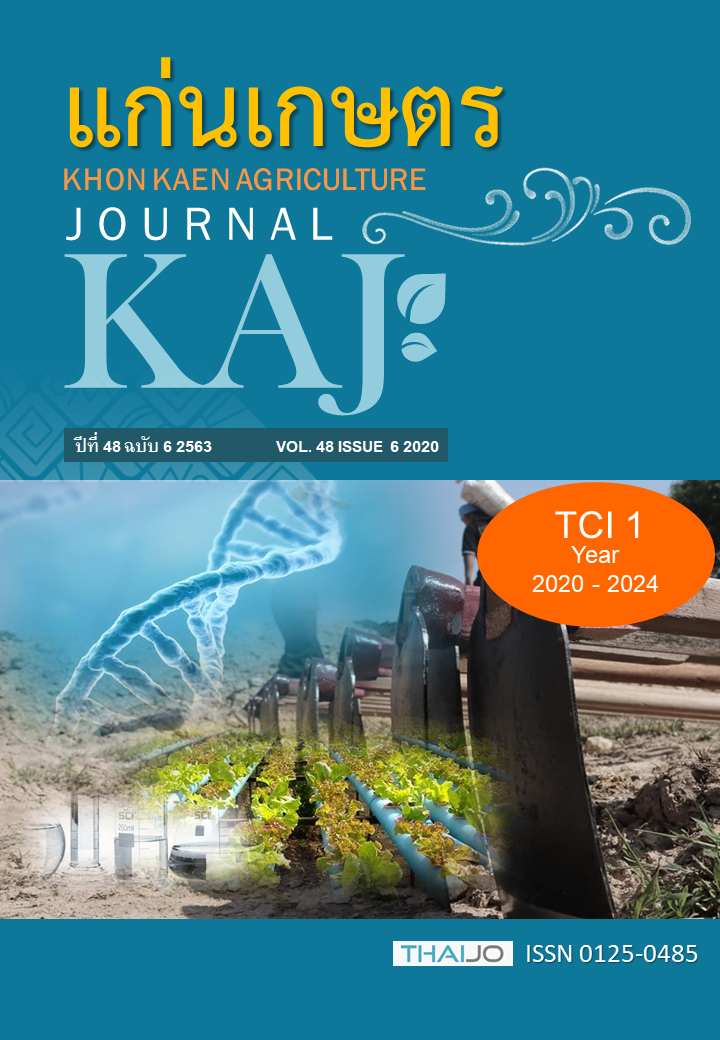ผลกระทบของโอโซนต่อการสรีรวิทยาและผลผลิตของข้าว กข43
Main Article Content
บทคัดย่อ
การเพิ่มขึ้นของก๊าซโอโซนสัมพันธ์กับปัญหามลพิษทางอากาศซึ่งจะส่งผลกระทบในวงกว้างต่อระบบนิเวศ โอโซนเป็นมลพิษทุติยภูมิที่เกิดจากปฏิกิริยาโฟโตเคมีคัล ระหว่างออกไซด์ของไนโตรเจน คาร์บอนมอนอกไซด์ มีเทน และสารอินทรีย์ระเหย กับแสงแดด มีการคาดการณ์ว่าโอโซนจะยังเพิ่มขึ้นอย่างต่อเนื่องในเขตเมืองรวมทั้งชนบท งานวิจัยนี้มีวัตถุประสงค์เพื่อศึกษาผลกระทบของระดับก๊าซโอโซนที่เพิ่มขึ้นต่อสรีรวิทยาและผลผลิตของข้าว กข43 โดยศึกษาผลกระทบของก๊าซโอโซนที่ระดับความเข้มข้นน 40 ppb (O340) ซึ่งเป็นความเข้มข้นที่เริ่มมีผลกระทบต่อพืช และก๊าซโอโซนที่ระดับความเข้มข้น 80 ppb (O380) ซึ่งเป็นความเข้มข้นที่คาดการณ์จะเกิดขึ้นในอนาคต และกลุ่มควบคุม (CF) เป็นเวลา 3 สัปดาห์ ศึกษาความสูง พื้นที่ใบ จำนวนกอ คลอโรฟิลล์ จำนวนรวง ความยาวรวง และจำนวนเมล็ดต่อรวงของข้าว กข43 พบว่าก๊าซโอโซนที่ระดับความเข้มข้น 80 ppb มีผลกระทบที่รุนแรงต่อข้าว กข43 โดยทั้งพื้นที่ใบ จำนวนกอ และคลอโรฟิลล์ ลดลงร้อยละ 44.65 39.20 และ 29.59 ตามลำดับ เมื่อเปรียบเทียบกับกลุ่มควบคุม (p ≤ 0.05) เช่นเดียวกับผลผลิต ที่พบว่าจำนวนรวงลดลงร้อยละ 47.85 ความยาวรวงลดลงร้อยละ 20.31 และเมล็ดต่อรวงลดลงร้อยละ 35.83 ในกลุ่มการทดลองโอโซน 80 ppb
Article Details
เอกสารอ้างอิง
สถาบันวิจัยข้าว. 2548. การใช้แผ่นเทียบสี (Leaf Color Chart) เพื่อการจัดการปุ๋ยไนโตรเจนในการปลูกข้าว
นาชลประทาน. แหล่งข้อมูล: http://www.ricethailand.go.th/rkb3/Eb_015.pdf. ค้นเมื่อ 23 มกราคม 2561.
Ainsworth, E.A. 2008. Rice production in a changing climate: a meta-analysis of responses to elevated carbon dioxide and elevated ozone concentration. Glob Change Biol. 14: 1642-1650.
Akhtar, N., M. Yamaguchi, H. Inada, D. Hoshino, T. Kondo, R.F. Fukami, and T. Izuta. 2010. Effects of ozone on growth, yield and leaf gas exchange rates of four Bangladeshi cultivars of rice (Oryza sativa L.). Environ Pollut. 158: 2970-2976.
Banerjee, A. and A. Roychoudhury. 2019. Chapter 19 - Rice Responses and Tolerance to Elevated Ozone. In Hasanuzzaman M., M. Fujita, K. Nahar, and J. K. Biswas (Eds.). Advances in Rice Research for Abiotic Stress Tolerance. Woodhead Publishing.
Calatayud, A. and E. Barreno. 2001. Chlorophyll a fluorescence, antioxidant enzymes and lipid peroxidation in tomato in response to ozone and benomyl. Environ Pollut. 115: 283-289.
Felzer, B.S., T. Cronin, J.M. Reilly, J.M. Melillo, and X. Wang. 2007. Impacts of ozone on trees and crops. CR GEOSCI. 339: 784 - 98.
Feng, Z., E. Hu, X. Wang, L. Jiang, and X. Liu. 2015. Ground-level O3 pollution and its impacts on food crops in China: A review. Environ Pollut. 199: 42-48.
Fiscus, E.L., F.L. Booker, and K.O. Burkey. 2005. Crop responses to ozone: uptake, modes of action, carbon assimilation and partitioning. Plant Cell Environ. 28: 997-1011.
Foyer, C.H., P. Descourvières, and K.J. Kunert. 1994. Protection against oxygen radicals: An important defence mechanism studied in transgenic plants. Plant Cell Environ. 17: 507–523.
Frei, M. 2015. Breeding of ozone resistant rice: Relevance, approaches and challenges. Environ Pollut. 197: 144-155.
IPCC. 2007. Climate Change. 2007. The Physical Science Basis. Contribution of Working Group I to the Fourth Assessment Report of the Intergovernmental Panel on Climate Change. In Solomon S, D. Qin, M. Manning, Z. Chen, M. Marquis, K.B. Averyt, (eds.). Cambridge University Press, Cambridge, United Kingdom and New York, NY, USA.
Kinose, Y., Y. Fukamachi, S. Okabe, H. Hiroshima, M. Watanabe, T. Izuta. 2017. Nutrient supply to soil offsets the ozone-induced growth reduction in Fagus crenata seedlings. Trees 31: 259–272.
Kumari, S., M. Agrawal, and S. Tiwari. 2013. Impact of elevated CO2 and elevated O3 on Beta vulgaris L.: Pigments, metabolites, antioxidants, growth and yield. Environ Pollut. 174: 279-288.
Kumari, S., M. Agrawal, and A. Singh. 2015. Effects of ambient and elevated CO2 and ozone on physiological characteristics, antioxidative defense system and metabolites of potato in relation to ozone flux. Environ Exp Bot. 109: 276-287.
Phothi, R., C. Umponstira, C. Sarin, W. Siriwong, and N. Nabheerong. 2016. Combining effects of ozone and carbon dioxide application on photosynthesis of Thai jasmine rice (Oryza sativa L.) cultivar Khao Dawk Mali 105. Aust J Crop Sci. 10: 591-597.
Phothi, R. and D.C. Theerakarunwong. 2017. Effect of chitosan on physiology, photosynthesis and biomass of rice (Oryza sativa L.) under elevated ozone. Aust J Crop Sci. 11: 624-630.
Saitanis, C.J., S.M. Bari, K.O. Burkey, D. Stamatelopoulos, and E. Agathokleous. 2014. Screening of Bangladeshi winter wheat (Triticum aestivum L.) cultivars for sensitivity to ozone. Environ Sci Pollut Res Int. 21: 13560-13571.
Sanz, J., I. González-Fernández, H. Calvete-Sogo, J.S. Lin, R. Alonso, R. Muntifering, and V. Bermejo. 2014. Ozone and nitrogen effects on yield and nutritive quality of the annual legume Trifolium cherleri. Atmos. 94: 765-772.
Sarkar, A. and S.B. Agrawal. 2010. Elevated ozone and two modern wheat cultivars: An assessment of dose dependent sensitivity with respect to growth, reproductive and yield parameters. Environ Exp Bot. 69: 328-337.
Sarkar, A. and S.B. Agrawal. 2012. Evaluating the response of two high yielding Indian rice cultivars against ambient and elevated levels of ozone by using open top chambers. J Environ Manage. 95: S19-S24.
Shang, B., X. Yuan, P. Li, Y. Xu, and Z. Feng. 2019. Effects of elevated ozone and water deficit on poplar saplings: Changes in carbon and nitrogen stocks and their allocation to different organs. Forest Ecol Manag. 441: 89-98.
Umponstira, C., W. Pimpa, and S. Nanegrungsun. 2006. Physiological and biochemical responses of cowpea (Vigna unguiculata (L.) Walp) to ozone. SJST. 28: 861-869.
Wu, H., Q. Li, C. Lu, L. Zhang, J. Zhu, F.A. Dijkstra, and Q. Yu. 2016. Elevated ozone effects on soil nitrogen cycling differ among wheat cultivars. Appl Soil Ecol. 108 (Supplement C): 187-194.
Zhu, D.W., H.C. Zhang, B.W. Guo, K. Xu, Q.G. Dai, H.Y. Wei, H. Gao, Y.J. Hu, P.Y. Cui, and Z.Y. Huo. 2017. Effects of nitrogen level on yield and quality of japonica soft super rice. J. Integr. Agric. 16: 1018-1027.


